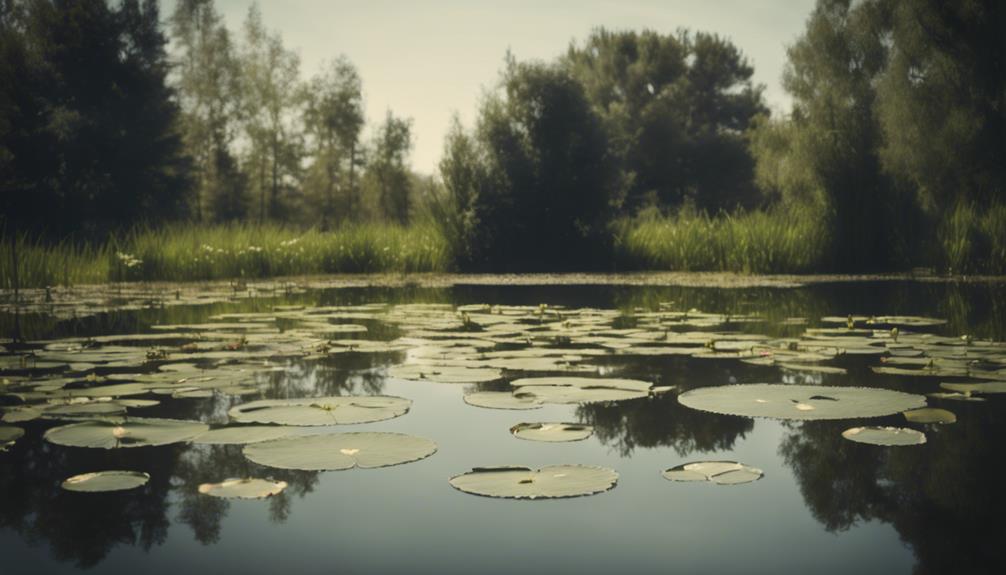You can naturally clear your pond water in 7 steps. First, determine your pond's size to select suitable equipment and maintain a healthy ecosystem. Next, prepare the pond environment by aerating, adding plants, and removing debris. Then, choose beneficial bacteria designed for your pond's unique needs and apply it according to the manufacturer's instructions. Monitor water clarity progress regularly to verify treatment effectiveness. Adjust and maintain balance by monitoring water chemistry and making adjustments as needed. Finally, sustain a healthy pond ecosystem by balancing fish, plants, and beneficial bacteria. By following these steps, you'll be on your way to crystal-clear water and a thriving ecosystem.
Table of Contents
Key Takeaways
- Determine pond size to select suitable equipment and maintain high-quality water, ensuring a healthy aquatic ecosystem.
- Prepare the pond environment by aerating, adding plants, and removing debris to prevent fish death and algae overgrowth.
- Apply beneficial bacteria products designed for the pond's unique needs, following the manufacturer's instructions for even distribution.
- Monitor water clarity progress regularly to verify treatment effectiveness and make adjustments as needed.
- Sustain a healthy pond ecosystem by balancing fish, plants, and beneficial bacteria, with regular water changes and proper filtration.
Determine Your Pond's Size
To effectively clear your pond water, you must first measure its surface area and volume, as these factors substantially impact the type and amount of treatment required.
This essential step sets the foundation for successful pond maintenance.
Knowing your pond's size enables you to select the right equipment, such as a suitable pump and filter, to maintain high-quality water.
For instance, a biological filter requires a specific volume of water to function efficiently.
Measure the length, width, and average depth of your pond to calculate its surface area and volume in gallons of water.
This data will guide your selection of equipment and inform your approach to pond maintenance.
A correct assessment of your pond's size guarantees you're providing the best possible environment for your aquatic ecosystem.
Prepare the Pond Environment
With your pond's size determined, you can now focus on preparing the environment to support a healthy ecosystem, starting with aeration and circulation. Aerate your pond to add oxygen to the bottom layer, preventing fish death and algae overgrowth. Consider investing in a pond rake to remove algae, debris, and muck from the pond. Add the right plants to keep water temperatures cooler, provide shade for fish, and restrict algae growth, aiming to cover 40-60% of the pond's surface area.
| Pond Preparation Step | Benefits | Tips |
|---|---|---|
| Aeration | Prevents fish death, algae overgrowth | Use a pond rake to remove debris |
| Plant Addition | Cools water, shades fish, restricts algae | Cover 40-60% of surface area |
| Debris Removal | Prevents ammonia spikes, fish harm | Remove debris before it decays |
Remove debris before it decays, as decaying debris, fish waste, and leftover food can cause ammonia levels to spike, harming fish. Verify that the pond pump is the correct size for the pond and waterfall, circulating the entire pond's water volume at least once every hour. Be cautious not to pump water higher than intended. By following these steps, you'll create a balanced environment for your pond, setting the stage for a thriving ecosystem.
Choose the Right Bacteria

You'll want to select a beneficial bacteria product specifically designed for your pond's unique needs and characteristics.
When choosing a product, consider the size of your pond, as well as its type and specific water quality issues. This confirms the product is effective and safe for aquatic life.
Look for products containing naturally occurring bacteria strains that are non-pathogenic, non-toxic, and safe for humans, pets, and wildlife.
Products like Natural Blast and Healthy Ponds are examples of beneficial bacteria products that can help maintain a healthy pond ecosystem.
By adding these beneficial bacteria to your pond, you'll be supporting the natural breakdown of excess nutrients, reducing algae growth, and improving water clarity.
Remember, the goal is to create an environment where the bacteria are working in harmony to keep your pond water healthy and clear.
Apply Beneficial Bacteria
After selecting the right beneficial bacteria product, apply it to your pond according to the manufacturer's instructions, taking care to verify the product is evenly distributed throughout the water column. This facilitates the bacteria's ability to effectively colonize and start breaking down decomposing organic matter.
By adding beneficial bacteria, you'll help keep your pond water clean and clear by accelerating the natural decomposition process. Beneficial bacteria are essential for ponds, as they help filter out waste and excess nutrients, keeping your pond looking healthy and thriving.
When adding bacteria, make sure to follow the recommended dosage to avoid over- or under-treating your pond. This will help improve the overall ecosystem and maintain clear water.
Monitor Water Clarity Progress

As you treat your pond with beneficial bacteria, track the water clarity progress regularly to verify the treatment is effective. You'll want to monitor the water clarity every few weeks to confirm the bacteria are doing their job.
Take note of any changes in the pond's appearance, such as a decrease in algae growth or an increase in dissolved oxygen levels.
Check the bottom of the pond for signs of excess nutrients, which can hinder the treatment's progress. If you notice the water is still murky, it may indicate that the bacteria need more time to break down the nutrients.
On the other hand, if the pond water is clean and clear, it's a good sign that the treatment is working.
As you monitor the water clarity, keep in mind that good quality pond water should be clear and free of algae growth. By tracking the progress regularly, you'll be able to identify any potential issues early on and make adjustments as needed.
Adjust and Maintain Balance
Maintaining a delicate balance of nutrients and beneficial bacteria is vital to sustaining ideal water clarity, and requires regular adjustments to prevent the ecosystem from shifting out of balance.
You'll need to keep a close eye on your pond's water chemistry to maintain harmony. Make adjustments as needed to prevent an algae problem from arising, which can quickly cloud your pond's water.
Improving water clarity also involves keeping your pond water free of excess organic matter, which can fuel algae growth. A properly installed aeration system and regular water testing will help you stay on top of things.
By maintaining balance, you'll keep your pond looking its best and support the health of your pond and its inhabitants. Remember, a thriving fish population relies on a balanced ecosystem, so it's crucial to monitor and adjust as needed.
Sustain a Healthy Pond Ecosystem

By sustaining a healthy pond ecosystem, you'll create an environment where fish, plants, and beneficial bacteria coexist in harmony, paving the way for crystal-clear water and a thriving aquatic community.
To achieve this, you'll need to strike a balance between these three components.
Maintain no more than 10 fish per 100 gallons of water to prevent over-population and maintain a healthy ecosystem.
Cover 40-60% of the pond's surface area with aquatic plants, which will absorb excess nutrients, provide shade, and maintain water clarity.
Perform regular water changes, guarantee proper filtration and aeration, and apply beneficial bacteria to maintain a healthy nitrogen cycle and prevent algae growth.
Frequently Asked Questions
How Do I Make My Pond Water Clear Naturally?
To clear your pond water naturally, you'll need to implement eco-friendly methods, such as pond aeration, water circulation, and introducing beneficial bacteria, natural filters, and plant balances, while maintaining regular testing and sediment removal.
Does Baking Soda Clear Pond Water?
You've likely heard the claim that baking soda clears pond water, but does it really? Let's explore the science: baking soda raises pH levels, but its effectiveness in algae control is a myth, and its benefits are often overstated.
Does Vinegar Clear Pond Water?
You're wondering if vinegar can clear your pond water? Well, vinegar's acidic effects can help control algae growth, but it may also lower pH levels, potentially harming aquatic life, so it's not a recommended natural remedy for ideal water clarity and quality.
How Do You Make a Natural Pond Cleaner?
You can create your own natural pond cleaner by combining algae control plant extracts, microbe boosters, and eco-friendly formulas with beneficial bacteria, then adding DIY recipes for natural aeration, water clarifiers, and organic remedies.
Conclusion
As you've navigated these 7 steps, your pond's water has transformed from murky to crystal clear, much like a butterfly emerging from its cocoon.
The once stagnant environment now teems with life, as beneficial bacteria work in harmony with nature.
Your pond's ecosystem is now a delicate balance of art and science, where every element flows together seamlessly.
With regular maintenance, your pond will continue to thrive, a serene oasis that reflects the beauty of nature itself.

